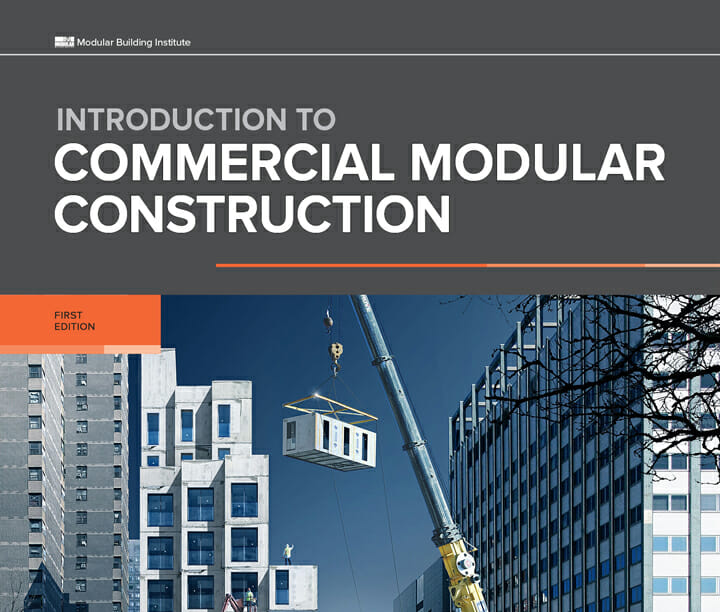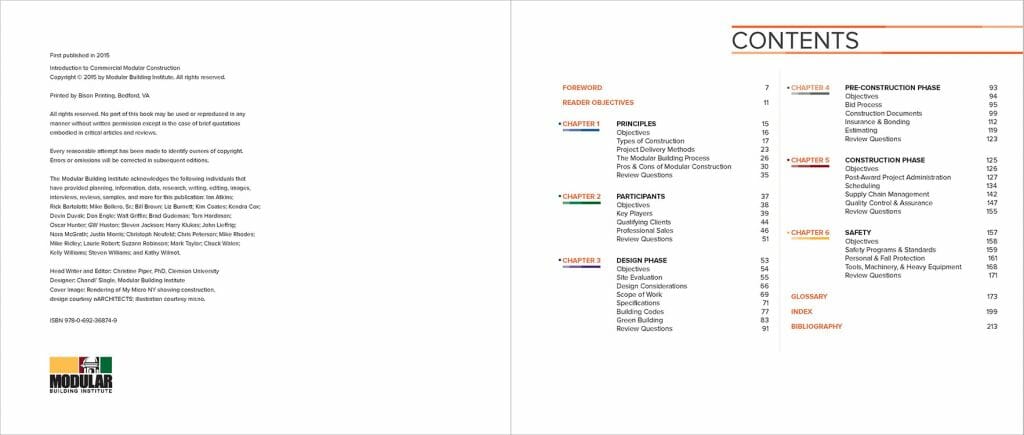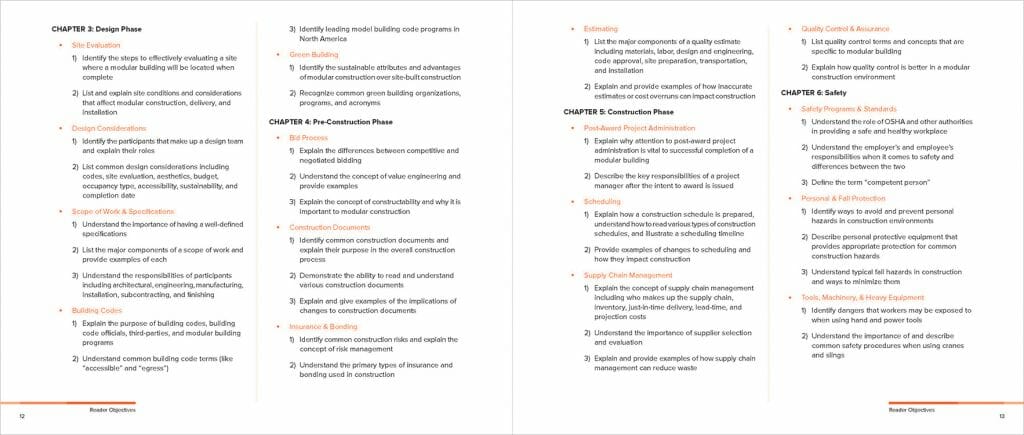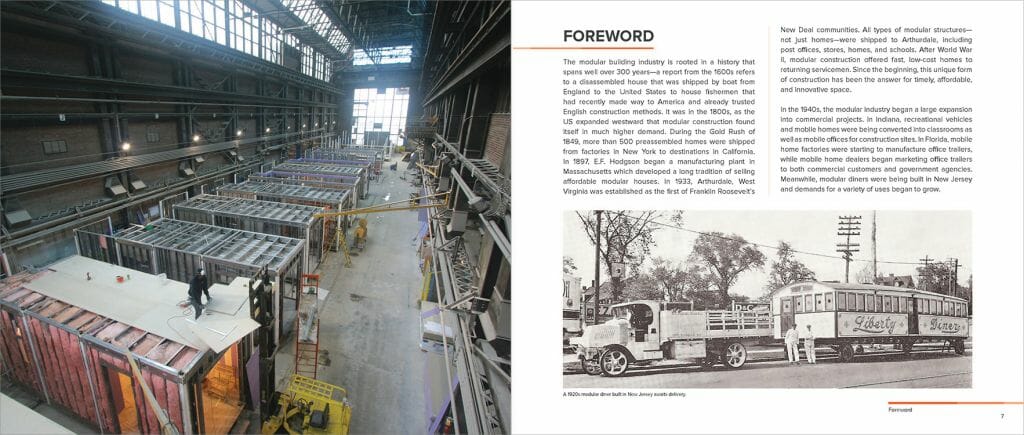Introduction to Commercial Modular Construction
A Book Every Modular Construction Professional Should Have in Their Library
The Modular Building Institute (MBI), along with Clemson University, developed "Introduction to Commercial Modular Construction" over two years with the goal of introducing the reader to an innovative and exciting construction method.
This book discusses the modular building process compared to traditional site-built construction and is designed to help the reader understand terminology and concepts of modular building including client needs, design, fabrication, transportation, and installation.

Introduction to Commercial Modular Construction
ISBN: 978-0-692-36874-9
Publisher: Modular Building Institute
Price: $99
Take a Look Inside MBI's Industry-Leading Textbook
MBI's “Introduction to Commercial Modular Construction” textbook offers a comprehensive introduction to the commercial modular construction industry. Created in consultation with industry professionals with decades of experience, there is no other resource that compares in terms of breadth and depth.
Click the preview pages below for a larger view.
Reader Objectives
"Introduction to Commercial Modular Construction" introduces readers to a building method known as commercial modular construction. It discusses the modular building process compared to traditional site-built construction and is designed to help readers understand the terminology and concepts of modular building, including inception of client needs, design, fabrication, transportation, and installation.
Chapter 1: Principles
Types of Construction
- Identify the various types of commercial modular construction including wood, steel, combustible, and noncombustible
- Describe each type of construction and give examples of typical occupancy types
Project Delivery Methods
- List and explain the types of project delivery methods including design-bid-build, design-built, and bid-design-build
- Explain why bid-design-build is popular in the modular construction industry
The Modular Building Process
- List the four stages of modular construction including design approval, factory construction, transportation, and assembly of modules and explain each
- Explain and illustrate how modular construction offers an accelerated construction timeline
Pros & Cons of Modular Construction
- List the advantages and benefits of modular construction over site-built construction in the areas of speed, green building, return on investment, logistics, and quality
- Recognize and provide examples of when modular construction may not be a practical solution
Chapter 2: Participants
Key Players
- Identify key participants involved throughout the modular building process including customers, manufacturers, dealers, design teams, subcontractors, installers, and code officials
- Describe and define each of their roles and responsibilities as they relate to modular construction
Qualifying Clients
- Understand the importance of information gathering when working with a customer and provide examples of types of information needed
- Explain why site analysis early in the process is critical to modular construction
- Identify and explain the major steps of qualifying a customer
Professional Sales
- Explain how frontline sales people shape the customer’s perception and experience
- List the steps of professional selling, including prospecting, pre-approach, presentation, and post-sale service
- Understand the role of ethics and professionalism in sales
Chapter 3: Design Phase
Site Evaluation
- Identify the steps to effectively evaluating a site where a modular building will be located when complete
- List and explain site conditions and considerations that affect modular construction, delivery, and
installation
Design Considerations
- Identify the participants that make up a design team and explain their roles
- List common design considerations including codes, site evaluation, aesthetics, budget, occupancy type, accessibility, sustainability, and completion date
Scope of Work & Specifications
- Understand the importance of having a well-defined specifications
- List the major components of a scope of work and provide examples of each
- Understand the responsibilities of participants including architectural, engineering, manufacturing, installation, subcontracting, and finishing
Building Codes
- Explain the purpose of building codes, building code officials, third-parties, and modular building programs
- Understand common building code terms (like “accessible” and “egress”)
- Identify leading model building code programs in North America
Green Building
- Identify the sustainable attributes and advantages of modular construction over site-built construction
- Recognize common green building organizations, programs, and acronyms
Chapter 4: Pre-Construction Phase
Bid Process
- Explain the differences between competitive and negotiated bidding
- Understand the concept of value engineering and provide examples
- Explain the concept of constructability and why it is important to modular construction
Construction Documents
- Identify common construction documents and explain their purpose in the overall construction process
- Demonstrate the ability to read and understand various construction documents
- Explain and give examples of the implications of changes to construction documents
Insurance & Bonding
- Identify common construction risks and explain the concept of risk management
- Understand the primary types of insurance and bonding used in construction
Estimating
- List the major components of a quality estimate including materials, labor, design and engineering, code approval, site preparation, transportation, and installation
- Explain and provide examples of how inaccurate estimates or cost overruns can impact construction
Chapter 5: Construction Phase
Post-Award Project Administration
- Explain why attention to post-award project administration is vital to successful completion of a modular building
- Describe the key responsibilities of a project manager after the intent to award is issued
Scheduling
- Explain how a construction schedule is prepared, understand how to read various types of construction schedules, and illustrate a scheduling timeline
- Provide examples of changes to scheduling and how they impact construction
Supply Chain Management
- Explain the concept of supply chain management including who makes up the supply chain, inventory, just-in-time delivery, lead-time, and projection costs
- Understand the importance of supplier selection and evaluation
- Explain and provide examples of how supply chain management can reduce waste
Quality Control & Assurance
- List quality control terms and concepts that are specific to modular building
- Explain how quality control is better in a modular construction environment
Chapter 6: Safety
Safety Programs & Standards
- Understand the role of OSHA and other authorities in providing a safe and healthy workplace
- Understand the employer’s and employee’s responsibilities when it comes to safety and differences between the two
- Define the term “competent person”
Personal & Fall Protection
- Identify ways to avoid and prevent personal hazards in construction environments
- Describe personal protective equipment that provides appropriate protection for common construction hazards
- Understand typical fall hazards in construction and ways to minimize them
Tools, Machinery, & Heavy Equipment
- Identify dangers that workers may be exposed to when using hand and power tools
- Understand the importance of and describe common safety procedures when using cranes and slings
Earn Your "Introduction to Commercial Modular Construction" Certificate
In addition to the textbook, MBI offers a complete set of interactive quizzes that allows readers to earn a "Introduction to Commercial Modular Construction" certificate of completion from the comfort of their home or office. A great option for employees at every experience level!




